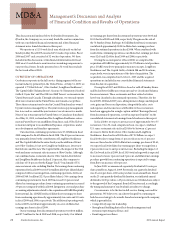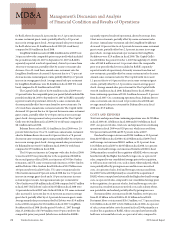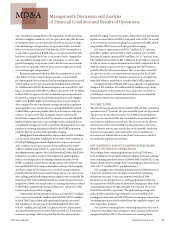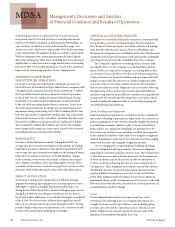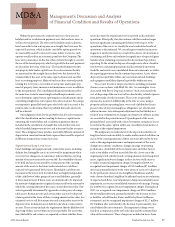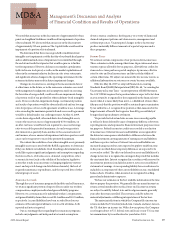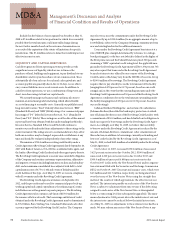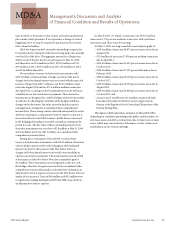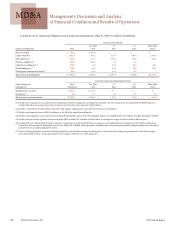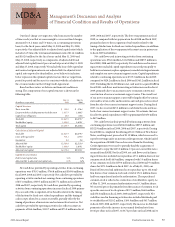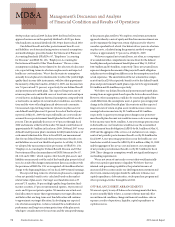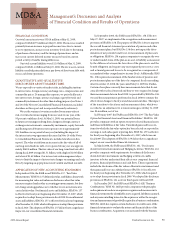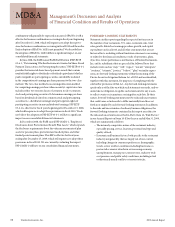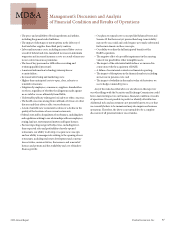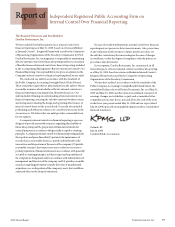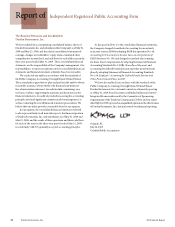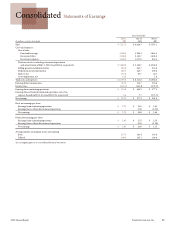Red Lobster 2009 Annual Report Download - page 33
Download and view the complete annual report
Please find page 33 of the 2009 Red Lobster annual report below. You can navigate through the pages in the report by either clicking on the pages listed below, or by using the keyword search tool below to find specific information within the annual report.
MD&A Management’s Discussion and Analysis
of Financial Condition and Results of Operations
2009 Annual Report Darden Restaurants, Inc. 31
time in whole or from time to time in part, at the principal amount
plus a make-whole premium. If we experience a change of control
triggering event, we may be required to purchase the New Senior
Notes from the holders.
All of our long-term debt currently outstanding is expected to
be repaid entirely at maturity with interest being paid semi-annually
over the life of the debt. The aggregate maturities of long-term
debt for each of the five fiscal years subsequent to May 31, 2009,
and thereafter are $0.0 million in 2010, $225.0 million in 2011,
$0.0 million in 2012, $350.0 million in 2013, $0.0 million in 2014
and $1.06 billion thereafter.
We entered into treasury-lock derivative instruments with
$150.0 million of notional value to hedge a portion of the risk of
changes in the benchmark interest rate associated with the expected
issuance of long-term debt to refinance our $150.0 million senior
notes due August 2010 and our $75.0 million medium-term notes
due April 2011, as changes in the benchmark interest rate will cause
variability in our forecasted interest payments. These derivative
instruments are designated as cash flow hedges and to the extent they
are effective in offsetting the variability of the hedged cash flows,
changes in the derivatives’ fair value are not included in current
earnings but are included in accumulated other comprehensive
income (loss). These changes in fair value will subsequently be reclas-
sified into earnings as a component of interest expense as interest is
incurred on the forecasted debt issuance. Ineffectiveness measured
in the hedging relationship is recorded currently in earnings in the
period it occurs. The fair value of these outstanding treasury-lock
derivative instruments was a net loss of $2.8 million at May 31, 2009
and is included, net of tax of $1.1 million, in accumulated other
comprehensive income (loss).
During the second quarter of fiscal 2008, we entered into
treasury-lock derivative instruments with $550.0 million of notional
value to hedge a portion of the risk of changes in the benchmark
interest rate prior to the issuance of the New Senior Notes, as
changes in the benchmark interest rate would cause variability in
our forecasted interest payments. These instruments were all settled
at the issuance of the New Senior Notes for a cumulative gain of
$6.2 million. These instruments were designated as effective cash
flow hedges, therefore, the gain was recorded in accumulated other
comprehensive income (loss) and is reclassified into earnings as an
adjustment to interest expense as interest on the New Senior Notes or
similar debt is incurred. Gains of $0.8 million and $0.5 million were
recognized in earnings during fiscal 2009 and 2008, respectively, as
an adjustment to interest expense.
In March 2007, we repaid, at maturity, our $150.0 million
unsecured 5.750 percent medium-term notes with cash from
operations and short-term borrowings.
At May 31, 2009, our long-term debt consisted principally of:
• $150.0 million of unsecured 4.875 percent senior notes due in
August 2010;
• $75.0 million of unsecured 7.450 percent medium-term notes
due in April 2011;
• $350.0 million of unsecured 5.625 percent senior notes due in
October 2012;
• $100.0 million of unsecured 7.125 percent debentures due in
February 2016;
• $500.0 million of unsecured 6.200 percent senior notes due in
October 2017;
• $150.0 million of unsecured 6.000 percent senior notes due in
August 2035;
• $300.0 million of unsecured 6.800 percent senior notes due in
October 2037; and
• An unsecured, variable rate $11.6 million commercial bank
loan due in December 2018 that is used to support a loan
from us to the Employee Stock Ownership Plan portion of the
Darden Savings Plan.
Through our shelf registration statement on file with the SEC,
depending on conditions prevailing in the public capital markets, we
may issue unsecured debt securities from time to time in one or more
series, which may consist of notes, debentures or other evidences of
indebtedness in one or more offerings.



